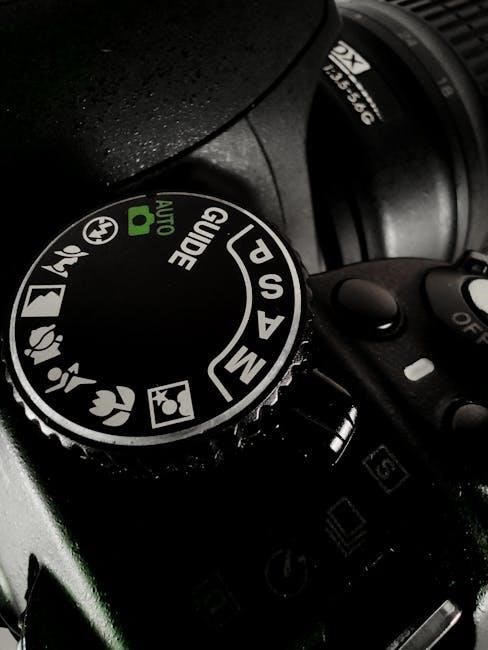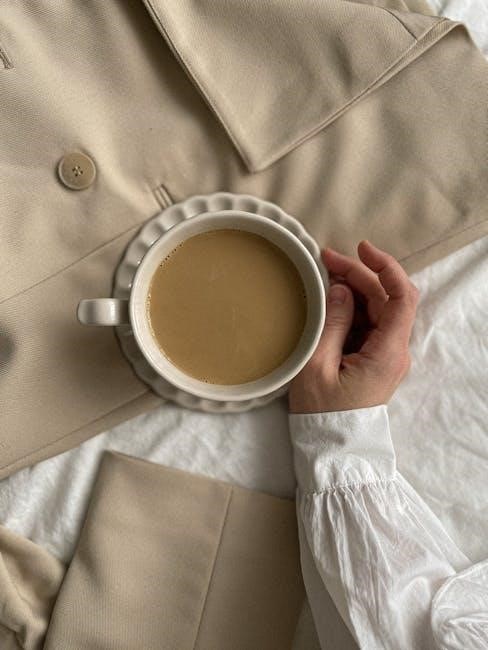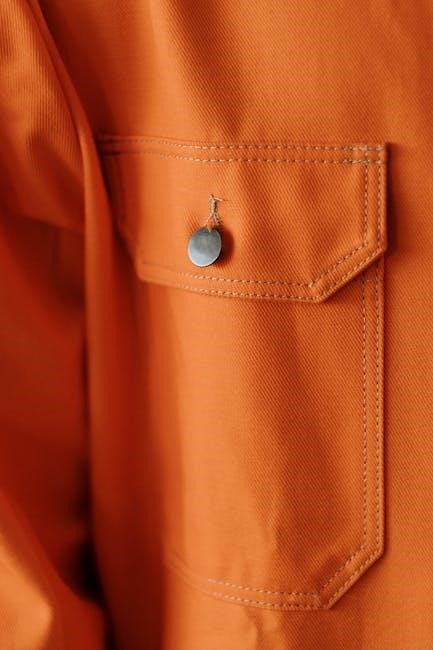This guide provides comprehensive insights into button sizing, helping you understand the importance of proper fit and aesthetics in clothing. Learn how to measure buttons accurately, convert units like ligne to millimeters, and choose the right sizes for various garments, ensuring a professional finish in your sewing projects.
1.1 Importance of Button Size in Clothing
Button size plays a crucial role in both functionality and aesthetics of garments. Properly sized buttons ensure secure fastening, durability, and a polished appearance. Incorrect sizing can lead to poor fit, compromised functionality, and an unbalanced look. For instance, oversized buttons on delicate fabrics may overwhelm the design, while undersized buttons can struggle to secure the garment effectively. Understanding the right button size ensures harmony between form and function, making it essential for tailors, designers, and sewists to achieve professional results in their creations.
1.2 Brief History of Standard Button Sizes
The concept of standard button sizes traces back to Europe, where buttons became a essential clothing fastener in the 18th century. Initially, buttons varied widely in size and shape, with no universal system. The introduction of the “ligne” system in France provided a standardized method for measuring buttons, with one ligne equaling 1/40 of an inch. This system gained popularity globally, enabling consistent production and sizing. Over time, industries adopted specific standards for different garments, such as shirts, jackets, and trousers, refining button sizes for functionality and aesthetics. This evolution has shaped modern button size guidelines, ensuring practicality and uniformity across clothing types.


Understanding Button Measurement
Button measurement involves using the “ligne” system, where 1 ligne equals 0.635 mm. This guide explains how to measure buttons accurately and convert units seamlessly for precise sizing in various garments.
2.1 What is “Ligne” and Its Role in Button Sizing
“Ligne” is a traditional unit of measurement for buttons, with 1 ligne equaling approximately 0.635 mm or 1/40 inch. Originating from French watchmaking, it became a standard in button manufacturing due to its precision. The ligne system allows for consistent sizing across different materials and styles, ensuring uniformity in button production. This unit is particularly useful in sewing and tailoring, as it provides a clear reference for selecting the appropriate button size for various garments, from delicate shirt buttons to larger coat buttons. Understanding ligne is essential for achieving professional results in clothing design and alteration.
2.2 Converting Ligne to Millimeters and Inches
Converting ligne to millimeters and inches is straightforward. One ligne equals approximately 0.635 mm or 1/40 inch, making it a precise unit for button sizing. To convert ligne to millimeters, multiply the ligne value by 0.635. For inches, divide the ligne value by 40. For example, 16L equals 10;24 mm or 0.406 inches, while 24L equals 15.24 mm or 0.603 inches. This conversion system ensures accurate measurements, helping you choose the right button size for your sewing or tailoring projects. Understanding these conversions is essential for achieving consistency in garment design.
2.3 How to Accurately Measure Button Size
To measure button size accurately, start by placing the button on a flat surface. Use a ruler or digital calipers to measure the diameter across the button’s center. Ensure the measurement is taken at the widest point for consistency. Convert the measurement to ligne by multiplying millimeters by 1.57 (since 1L ≈ 0.635 mm). For inches, divide the millimeter measurement by 25.4. Digital calipers provide the most precise readings. Accurate measurement ensures the button fits seamlessly into your garment design, maintaining both functionality and aesthetic appeal.

Standard Button Sizes for Common Garments
Discover standard button sizes for shirts, jackets, trousers, and sleeves. Learn the typical measurements ensuring functionality and style across various garments with this guide today.
3.1 Shirt Buttons: Sizes and Applications
Shirt buttons typically range from 16L to 24L, with 18L being a common size for dress shirts. Smaller buttons, like 16L, are often used on collars, while larger ones, such as 20L to 24L, are placed on the placket. Cuff buttons usually fall between 15L to 18L. The size choice depends on the shirt’s style and intended use, ensuring both functionality and visual appeal. Regional differences may also influence button size preferences, with American styles often favoring slightly larger buttons than European designs. Using a size chart helps in selecting the perfect fit for a polished look.
3.2 Jacket and Coat Buttons: Standard Sizes
Jacket and coat buttons typically range from 24L to 40L, with 24L being common for blazers and 32L for coats. Suit jackets often use 36L, while overcoats may feature larger buttons, such as 40L. The size choice depends on the garment’s proportions, ensuring buttons are neither too small nor overpowering. Using a button size chart helps in selecting the ideal size, balancing functionality and aesthetics for a tailored look. Proper sizing enhances both comfort and visual harmony, making it essential for achieving a professional finish.
3.3 Trousers and Shorts: Ideal Button Sizes
Trousers and shorts typically use larger buttons than shirts, with standard sizes ranging from 24L to 36L. For men’s trousers, 28L is common, while women’s styles often use 24L or 26L. Shorts may use slightly smaller buttons, around 20L to 24L, for a more subtle look. The choice depends on the garment’s design and intended use, with larger buttons providing durability for heavier fabrics. Using a button size chart ensures the right fit, balancing functionality and aesthetics for a polished finish in your sewing projects.
3.4 Sleeve Buttons: Size Recommendations
Sleeve buttons are typically smaller than those used on shirts or jackets, often ranging from 16L to 20L. These buttons are designed to complement the sleeve’s design without overpowering it. For a classic look, 18L or 20L buttons are ideal, while smaller sizes like 16L can add a touch of elegance. The choice depends on the sleeve’s width and the overall garment style, ensuring a balanced and visually appealing finish. Using a button size chart helps in selecting the perfect fit for sleeves, enhancing both functionality and aesthetics in your sewing projects.

Button Size Charts and Conversion Tables
Discover essential charts and tables for accurate button sizing. Convert ligne to millimeters and inches effortlessly, ensuring perfect measurements for sewing projects. Downloadable and printable guides available.
4.1 Printable Button Size Chart for Sewing
A printable button size chart is a must-have tool for sewists. It provides actual-size visuals and measurements in ligne, millimeters, and inches for common button sizes. Whether you’re replacing buttons or starting a new project, this chart ensures accuracy. Download and keep it handy in your sewing room to avoid the hassle of measuring each button manually. It covers sizes from 10L to 40L, making it versatile for shirts, jackets, trousers, and more. Print it on high-quality paper for clear visibility and durability.
4.2 Ligne to Millimeter Conversion Chart
Understanding the conversion from ligne to millimeters is essential for accurate button sizing. One ligne equals approximately 0.635 millimeters, making it a precise unit for measuring buttons. A conversion chart provides a clear reference, listing common button sizes in both ligne and millimeters. For example, 10L equals 6.35mm, 16L equals 10.24mm, and 24L equals 15.36mm. This chart is invaluable for sewists and designers, ensuring buttons fit seamlessly into garments. It helps maintain consistency and avoids sizing errors, making it a go-to resource for any sewing project.
4.3 Inches to Ligne Conversion Guide
Converting inches to ligne is straightforward, as 1 inch equals 40 ligne. This guide helps translate standard button sizes from inches to ligne, ensuring precise measurements. For example, a 1/4 inch button is 10L, while a 1/2 inch button is 20L. Common sizes like 5/8 inch (25L) and 3/4 inch (30L) are also included. This chart is essential for designers and sewists, offering a quick reference to match button sizes accurately. It simplifies the process of selecting the right buttons for your projects, ensuring a professional and consistent finish every time.

Application-Specific Button Sizes
Discover button sizes tailored for specific garments, from dress shirts to jackets and children’s clothing, ensuring optimal fit and functionality for every application.
5.1 Dress Shirts: Button Size Standards
Dress shirt buttons typically range from 18L to 22L, with 20L being the most common size. Smaller buttons, like 16L, are often used on cuffs, while larger ones, such as 24L, may be used for a more robust look. The size depends on the shirt’s style and material, ensuring functionality and aesthetics. Proper button size ensures a smooth fit and prevents gaps, maintaining a polished appearance. Always choose buttons that align with the shirt’s design to achieve the perfect balance between practicality and style.
5.2 Suit Jackets: Button Size Guidelines
Suit jacket buttons typically range from 24L to 40L, with 30L to 36L being the most common sizes. Larger buttons, such as 40L, are often used on heavier fabrics or for a more structured look. Smaller buttons, like 24L, provide a sleek, modern aesthetic. Button size should complement the jacket’s proportions and material, ensuring a balanced appearance. For example, a double-breasted jacket might use larger buttons for emphasis, while a slim-fit jacket could opt for smaller ones. Choosing the right size enhances both functionality and style, ensuring a polished finish.
5.3 Children’s Clothing: Button Size Recommendations
For children’s clothing, button sizes are smaller and more proportionate to the garment. Shirt buttons for kids typically range from 16L to 20L, while jackets and trousers may use slightly larger sizes, around 20L to 24L. The size should ensure functionality and comfort, avoiding buttons that are too small or difficult for children to manage. Buttons for younger children often prioritize durability and safety, with secure stitching to prevent detachment. Choosing the right size enhances both fit and practicality, ensuring garments are easy for children to wear and maintain.
5.4 Accessories: Button Sizes for Hats and Bags
Button sizes for accessories like hats and bags are typically smaller, ranging from 10L to 16L, ensuring a subtle yet functional design. These buttons are chosen for their proportionate fit, blending seamlessly with the overall aesthetic of the accessory. For hats, smaller buttons like 12L or 14L are common, while bags may use slightly larger sizes, up to 16L, for added durability and ease of use. The size selection often prioritizes style and practicality, ensuring buttons complement the accessory without overwhelming its design.

The Impact of Button Size on Fit and Aesthetics
Button size significantly impacts both fit and aesthetics, affecting comfort and visual harmony. Incorrect sizing can compromise functionality and style, making balance crucial for a polished look.
6.1 How Button Size Affects Garment Fit
Button size plays a crucial role in ensuring proper garment fit and comfort. Ill-fitting buttons can lead to misalignment, gapping, or tightness, compromising both functionality and aesthetics. Oversized buttons may strain stitching, while undersized ones can cause difficulty in fastening, affecting overall usability. Properly sized buttons ensure seamless integration with fabric, maintaining structural integrity and preventing wear. For instance, shirts typically use 18L to 22L buttons, while jackets often require larger sizes like 24L to 32L. Accurate button sizing is essential for achieving a balanced, professional finish in any garment.
6.2 Button Size and Visual Proportionality

Button size significantly impacts the visual balance of a garment. Properly proportioned buttons enhance aesthetics, ensuring harmony with the garment’s scale and design. Larger buttons suit bulky fabrics or oversized designs, while smaller ones complement delicate textures. For example, shirts often use 18L to 22L buttons, aligning with their streamlined appearance. Jacket buttons, typically 24L to 32L, create a balanced look on heavier fabrics. Consistent button sizing and spacing are vital for a polished, professional finish, as mismatched sizes can disrupt the overall visual appeal of the garment.

Challenges in Standardizing Button Sizes

Standardizing button sizes is challenging due to variability across brands and regional differences in sizing standards, making consistency difficult to achieve globally.
7.1 Variability in Clothing Sizes Across Brands
Variability in clothing sizes across brands poses a significant challenge in standardizing button sizes. Each brand often follows its own sizing guidelines, leading to inconsistencies in button measurements. For instance, a size 16L button in one brand might differ from another, complicating the selection process for consumers and manufacturers alike. This lack of uniformity stems from differing design approaches and target markets, making it difficult to establish a universal standard for button sizes across the industry.
This response is generated based on the provided information and adheres to the specified requirements.
7.2 Regional Differences in Button Size Standards
Regional differences in button size standards add another layer of complexity to the standardization process. Clothing sizes and button preferences vary significantly across different countries and regions. For example, Asian sizing tends to be smaller than US or EU sizes, while historical data shows that clothing sizes have evolved over time. Initiatives like “Size India” aim to create standardized size charts for clothing in specific regions, highlighting the need for localized solutions. These regional disparities make it challenging to establish a universal button size standard, as preferences and measurements differ widely.
8.1 Key Takeaways from the Button Size Guide
Button sizing is essential for ensuring proper fit and aesthetics in clothing. Standard sizes vary across garments, with shirts typically using 16-24L, jackets 32-40L, and trousers 20-28L. Understanding measurements like ligne, millimeters, and inches is crucial for accurate sizing. Using conversion charts can simplify selecting the right button size. Proper sizing enhances both functionality and visual appeal, making it vital for professional sewing projects. Consistency in sizing helps maintain a polished look, while standardization challenges across brands highlight the need for careful measurement and reference to reliable size guides.
8.2 Final Thoughts on Choosing the Right Button Size
Selecting the right button size is crucial for both functionality and style. Properly sized buttons ensure a secure closure and balanced aesthetics. Referencing standard charts and understanding measurements like ligne, millimeters, and inches can guide your choices. Consider the garment type, as shirts, jackets, and trousers each have specific size ranges. While universal standards exist, variations across brands highlight the importance of careful measurement. Investing time in selecting the perfect button size enhances the quality and appearance of your projects, ensuring a professional finish every time.
